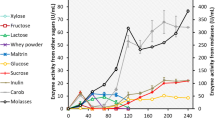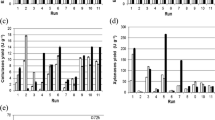Abstract
Inulinases are enzymes of great interest in the food industry, especially due to their application in the synthesis of fructose and fructo-oligosaccharides. Moreover, some inulinases (I) also present invertase activity (S), making them useful for sucrose hydrolysis processes. In the present study, the production of inulinase by Aspergillus niger URM5741 was evaluated and optimized using two statistical approaches. First, the composition of the cultivation medium was determined through a simplex centroid mixture design, followed by the selection of optimal fermentation conditions using the Box–Behnken design. Based on these experimental designs, the maximum activities of inulinase (16.68 U mL−1) and invertase (27.80 U mL−1) were achieved using a mixture of wheat, soy, and oat brans (5 g), along with 2.5% inulin and 40% moisture. The inulinase exhibited optimum temperature and pH of 60 °C and 4.0, respectively, displayed a high affinity for both substrates, as evidenced by very-low Michaelis constant values (1.07–1.54 mM). A relative thermostability was observed at 55–60 °C as indicated by half-lives values (I: 169.06–137.27 min; S: 173.29–141.52 min) and D-values (I: 561.61–456.00 min; S: 575.65–470.11 min) which were further confirmed by the high activation energy (123.01 and 143.29 kJ mol−1). The enzyme demonstrated favorable results in terms of inulin and sucrose hydrolysis, being a maximum release of reducing sugars of 6.04 and 15.80 g L−1, respectively. These results indicate that the sequential statistical approach proved to be beneficial to produce inulinase by A. niger URM5741, with the obtained enzyme considered promising for long-term industrial applications.







Similar content being viewed by others
Data availability
The data presented in this study are available on request from the corresponding author.
References
Abd El Aty AA, Wehaidy HR, Mostafa FA (2014) Optimization of inulinase production from low cost substrates using Plackett-Burman and Taguchi methods. Carbohydr Polym 102:261–268. https://doi.org/10.1016/j.carbpol.2013.11.007
Batista RD, Guimarães Melo F, Auler do Amaral Santos CC et al (2021) Optimization of β-fructofuranosidase production from agrowaste by Aspergillus carbonarius and its application in the production of inverted sugar. Food Technol Biotechnol 59:306–313. https://doi.org/10.17113/ftb.59.03.21.6934
Bradford MM (1976) A rapid and sensitive method for the quantitation of microgram quantities of protein utilizing the principle of protein-dye binding. Anal Biochem 72:248–254. https://doi.org/10.1016/0003-2697(76)90527-3
Carboué Q, Claeys-Bruno M, Bombarda I et al (2018) Experimental design and solid state fermentation: a holistic approach to improve cultural medium for the production of fungal secondary metabolites. Chemom Intell Lab Syst 176:101–107. https://doi.org/10.1016/j.chemolab.2018.03.011
Catana R, Ferreira BS, Cabral JMS, Fernandes P (2005) Immobilization of inulinase for sucrose hydrolysis. Food Chem 91:517–520. https://doi.org/10.1016/j.foodchem.2004.04.041
Chen HQ, Chen XM, Li Y et al (2009) Purification and characterisation of exo- and endo-inulinase from Aspergillus ficuum JNSP5-06. Food Chem 115:1206–1212. https://doi.org/10.1016/j.foodchem.2009.01.067
Converti A, Pessoa A, Silva JC et al (2021) Thermodynamics applied to biomolecules. In: Pessoa A, Vitolo M, Long PF (eds) Pharmaceutical biotechnology, 1st edn. CRC Press, Boca Raton, pp 29–42
Das D, Bhat MR, Selvaraj R (2019a) Review of inulinase production using solid-state fermentation. Ann Microbiol 69:201–209. https://doi.org/10.1007/s13213-019-1436-5
Das D, Selvaraj R, Ramananda Bhat M (2019b) Optimization of inulinase production by a newly isolated strain Aspergillus flavus var. flavus by solid state fermentation of Saccharum arundinaceum. Biocatal Agric Biotechnol 22:101363. https://doi.org/10.1016/j.bcab.2019.101363
Das D, Bhat MR, Selvaraj R (2020) Optimization of inulinase production by a newly isolated Penicillium amphipolaria strain using solid-state fermentation of hardy sugarcane stems. Biocatal Agric Biotechnol 30:101875. https://doi.org/10.1016/j.bcab.2020.101875
de Carvalho MS, de Menezes LHS, Pimentel AB et al (2022) Application of chemometric methods for the optimization secretion of xylanase by Aspergillus oryzae in solid state fermentation and its application in the saccharification of agro-industrial waste. Waste Biomass Valoriz. https://doi.org/10.1007/s12649-022-01832-8
de Oliveira RL, da Silva MF, Converti A, Porto TS (2020) Production of β-fructofuranosidase with transfructosylating activity by Aspergillus tamarii URM4634 Solid-State Fermentation on agroindustrial by-products. Int J Biol Macromol 144:343–350. https://doi.org/10.1016/j.ijbiomac.2019.12.084
de Oliveira RL, da Silva SP, Converti A, Porto TS (2022) Production, biochemical characterization, and kinetic/thermodynamic study of inulinase from Aspergillus terreus URM4658. Molecules 27:6418. https://doi.org/10.3390/molecules27196418
Dixon M, Webb EC (1979) Enzyme inhibition and inactivation. In: Dixon M, Webb EC (eds) Enzymes, 3rd edn. Longman, London, pp 332–467
Elias M, Wieczorek G, Rosenne S, Tawfik DS (2014) The universality of enzymatic rate-temperature dependency. Trends Biochem Sci 39:1–7. https://doi.org/10.1016/j.tibs.2013.11.001
Garai D, Kumar V (2013) A Box-Behnken design approach for the production of xylanase by Aspergillus candidus under solid state fermentation and its application in saccharification of agro residues and Parthenium hysterophorus L. Ind Crops Prod 44:352–363. https://doi.org/10.1016/j.indcrop.2012.10.027
Germec M, Turhan I (2019) Evaluation of carbon sources for the production of inulinase by Aspergillus niger A42 and its characterization. Bioprocess Biosyst Eng 42:1993–2005. https://doi.org/10.1007/s00449-019-02192-9
Guerrero-Urrutia C, Volke-Sepulveda T, Figueroa-Martinez F, Favela-Torres E (2021) Solid-state fermentation enhances inulinase and invertase production by Aspergillus brasiliensis. Process Biochem 108:169–175. https://doi.org/10.1016/j.procbio.2021.06.014
Kumar R, Kesavapillai B (2012) Stimulation of extracellular invertase production from spent yeast when sugarcane pressmud used as substrate through solid state fermentation. Springerplus 1:81. https://doi.org/10.1186/2193-1801-1-81
Magadum DB, Yadav GD (2018) Fermentative production, purification of inulinase from Aspergillus terreus MTCC 6324 and its application for hydrolysis of sucrose. Biocatal Agric Biotechnol 14:293–299. https://doi.org/10.1016/j.bcab.2018.03.020
Mandari V, Nema A, Devarai SK (2020) Sequential optimization and large scale production of lipase using tri-substrate mixture from Aspergillus niger MTCC 872 by solid state fermentation. Process Biochem 89:46–54. https://doi.org/10.1016/j.procbio.2019.10.026
Miłek J (2020) Determination of optimum temperatures and activation energies of inulin hydrolysis by endo-inulinase Aspergillus niger. Chem Process Eng Inz Chem I Proces 41:229–236. https://doi.org/10.24425/cpe.2020.132545
Miłek J (2022a) Application of the new method to determine the activation energies and optimum temperatures of inulin hydrolysis by exo-inulinases Aspergillus niger. J Therm Anal Calorim 147:1371–1377. https://doi.org/10.1007/s10973-020-10495-3
Miłek J (2022b) The inulin hydrolysis by recombinant exo-inulinases: determination the optimum temperatures and activation energies. J Therm Anal Calorim 147:8061–8067. https://doi.org/10.1007/s10973-021-11086-6
Miller G (1959) Use of dinitrosalicylic acid reagent for determination reducing sugar. Anal Chem 31:426–428
Mohamed SA, Salah HA, Moharam ME et al (2015) Characterization of two thermostable inulinases from Rhizopus oligosporus NRRL 2710. J Genet Eng Biotechnol 13:65–69. https://doi.org/10.1016/j.jgeb.2014.12.001
Mohan A, Flora B, Girdhar M (2018) Inulinase: an important microbial enzyme in food industry. Microbial bioprospecting for sustainable development. Springer Singapore, Singapore, pp 237–248
Ohara A, dos Santos JG, Angelotti JAF et al (2018) A multicomponent system based on a blend of agroindustrial wastes for the simultaneous production of industrially applicable enzymes by solid-state fermentation. Food Sci Technol. https://doi.org/10.1590/1678-457x.17017
Paul I, Kumar CG (2020) Fungal biofactories as potential inulinase sources for production of fructooligosaccharides. In: Singh J, Gehlot P (eds) New and future developments in microbial biotechnology and bioengineering, 1st edn. Elsevier, Amsterdam, pp 183–210
Rawat HK, Jain SC, Kango N (2015) Production and properties of inulinase from Penicillium sp. NFCC 2768 grown on inulin-rich vegetal infusions. Biocatal Biotransformation 33:61–68. https://doi.org/10.3109/10242422.2015.1018188
Riaz M, Perveen R, Javed MR et al (2007) Kinetic and thermodynamic properties of novel glucoamylase from Humicola sp. Enzyme Microb Technol 41:558–564. https://doi.org/10.1016/j.enzmictec.2007.05.010
Sadh PK, Duhan S, Duhan JS (2018) Agro-industrial wastes and their utilization using solid state fermentation: a review. Bioresour Bioprocess 5:1–15. https://doi.org/10.1186/s40643-017-0187-z
Sahin YB, Demirtas EA, Burnak N (2016) Mixture design: a review of recent applications in the food industry. Pamukkale Univ J Eng Sci 22:297–304. https://doi.org/10.5505/pajes.2015.98598
Saleh SAA, Abd El-Galil AA, Sakr EAE et al (2020) Physiochemical, kinetic and thermodynamic studies on Aspergillus wewitschiae MN056175 inulinase with extraction of prebiotic and antioxidant Cynara scolymus leaves fructo-oligosaccharides. Int J Biol Macromol 163:1026–1036. https://doi.org/10.1016/j.ijbiomac.2020.07.036
Saqib AAN, Hassan M, Khan NF, Baig S (2010) Thermostability of crude endoglucanase from Aspergillus fumigatus grown under solid state fermentation (SSF) and submerged fermentation (SmF). Process Biochem 45:641–646. https://doi.org/10.1016/j.procbio.2009.12.011
Silva MF, Rigo D, Mossi V et al (2013) Evaluation of enzymatic activity of commercial inulinase from Aspergillus niger immobilized in polyurethane foam. Food Bioprod Process 91:54–59. https://doi.org/10.1016/j.fbp.2012.08.003
Singh RS, Singh RP (2017) Inulinases. In: Larroche C, Sanromán MÁ, Du G, Pandey A (eds) Current developments in biotechnology and bioengineering, 1st edn. Elsevier, Amsterdam, pp 423–446
Singh RS, Singh RP, Kennedy JF (2016) Recent insights in enzymatic synthesis of fructooligosaccharides from inulin. Int J Biol Macromol 85:565–572. https://doi.org/10.1016/j.ijbiomac.2016.01.026
Singh RS, Chauhan K, Kennedy JF (2017) A panorama of bacterial inulinases: production, purification, characterization and industrial applications. Int J Biol Macromol 96:312–322. https://doi.org/10.1016/j.ijbiomac.2016.12.004
Singh RS, Chauhan K, **dal A (2018a) Response surface optimization of solid state fermentation for inulinase production from Penicillium oxalicum using corn bran. J Food Sci Technol 55:2533–2540. https://doi.org/10.1007/s13197-018-3173-3
Singh RS, Chauhan K, Pandey A et al (2018b) Purification and characterization of two isoforms of exoinulinase from Penicillium oxalicum BGPUP-4 for the preparation of high fructose syrup from inulin. Int J Biol Macromol 118:1974–1983. https://doi.org/10.1016/j.ijbiomac.2018.07.040
Singh RS, Chauhan K, Kennedy JF (2019) Fructose production from inulin using fungal inulinase immobilized on 3-aminopropyl-triethoxysilane functionalized multiwalled carbon nanotubes. Int J Biol Macromol 125:41–52. https://doi.org/10.1016/j.ijbiomac.2018.11.281
Souza PM, Aliakbarian B, **menes E et al (2015) Kinetic and thermodynamic studies of a novel acid protease from Aspergillus foetidus. Int J Biol Macromol 81:17–21. https://doi.org/10.1016/j.ijbiomac.2015.07.043
Wahba MI, Saleh SAA, Mostafa FA, Abdel Wahab WA (2022) Immobilization impact of GEG-Alg-SPI as a carrier for Aspergillus niger MK981235 inulinase: kinetics, thermodynamics, and application. Bioresour Technol Reports 18:101099. https://doi.org/10.1016/j.biteb.2022.101099
**ong Y-H, Liu J-Z, Song H-Y, Ji L-N (2005) Purification, kinetic and thermodynamic studies of a new ribonuclease from a mutant of Aspergillus niger. J Biotechnol 119:348–356. https://doi.org/10.1016/j.jbiotec.2005.04.008
Acknowledgements
The corresponding author is grateful to the National Council for Scientific and Technological Development (CNPq, Brazil) and to the Foundation for Science and Technology of the State of Pernambuco (FACEPE, Brazil) for post-doctoral scholarship (Grants 304905/2021-6 and DCR-0037-5.07/21, respectively) and to the Federal University of the Agreste of Pernambuco (UFAPE) for the support and laboratory infrastructure.
Author information
Authors and Affiliations
Corresponding author
Ethics declarations
Conflict of interest
The authors declare that they have no conflict of interest.
Rights and permissions
Springer Nature or its licensor (e.g. a society or other partner) holds exclusive rights to this article under a publishing agreement with the author(s) or other rightsholder(s); author self-archiving of the accepted manuscript version of this article is solely governed by the terms of such publishing agreement and applicable law.
About this article
Cite this article
da Silva, W.B., Porto, T.S., da Silva, S.P. et al. Optimization strategy for inulinase production by Aspergillus niger URM5741 and its biochemical characterization, kinetic/thermodynamic study, and application on inulin and sucrose hydrolysis. 3 Biotech 13, 376 (2023). https://doi.org/10.1007/s13205-023-03790-x
Received:
Accepted:
Published:
DOI: https://doi.org/10.1007/s13205-023-03790-x




